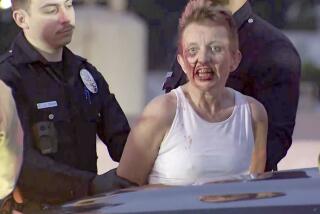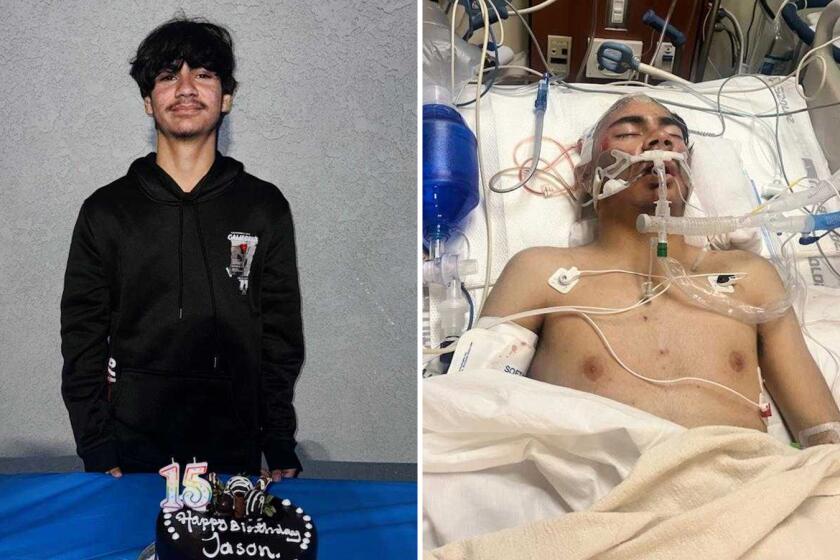‘3 Strikes’ Case Leniency Is Out in O.C. : Courts: Prosecutors tighten up policy of sometimes ignoring prior convictions if latest crime wasn’t violent.
A petty thief with a long criminal history, Jesus A. Martinez was arrested in July at a Fullerton HomeBase, a wrench, some pliers and a pair of vice grips tucked in his waistband, police said.
The value of the items allegedly stolen: $42.52. But if prosecutors have their way, it will cost the 44-year-old man much, much more. Possibly the rest of his life.
Martinez is among the first 94 defendants charged in Orange County under “three strikes” legislation, a new law that aims to punish repeat offenders with lengthier prison terms.
If found guilty at trial next month, Martinez, who has prior convictions for assault with a deadly weapon and burglary, faces 25 years to life in prison--a harsher sentence than some murderers get.
The new sentencing law is the legacy of Polly Klaas, a Petaluma 12-year-old who was kidnaped and murdered late last year, authorities contend, by a newly paroled career criminal.
The case sparked a public outcry over the criminal justice system’s seeming inability to keep habitual offenders behind bars, and prompted the state Legislature to resurrect a bill that mandates life sentences for third-time felons who have two or more convictions for serious or violent crimes.
Promising it would help make California residents safer from violent criminals, Gov. Pete Wilson signed the bill in March, and an initiative--Proposition 184--on the November general election ballot seeks to make “three strikes” part of the state Constitution.
In Orange County, however, the new law has thus far ensnared mainly drug users and burglars, underscoring the complaints of critics who say that the law targets the wrong defendants, threatens to create a logjam in the courts and will possibly bankrupt the state by forcing an unprecedented prison-building program.
Of the 94 men and women charged under the new law, fewer than 20 face new felony charges for crimes of violence, according to a list of “three strikes” defendants compiled by the Orange County district attorney’s office.
But Orange County’s cases also illustrate the argument advanced by supporters of the law: The majority of the defendants have prior convictions for crimes involving force or fear or face a third “strike” for a violent crime.
The full impact of the legislation has not yet been felt in Orange County, where only two defendants have been convicted and await sentencing under the new law.
But a 35% to 50% increase in jury trials scheduled for Superior Court this year has been attributed largely to the new law, and some fear that “three strikes” ultimately could cost Orange County taxpayers millions of dollars in expanded jail space, additional jury trials, more intensive investigation by law enforcement and other services. The public defender’s office has already asked the county for $576,000 to handle the fallout.
In the meantime, some “three strikes” defendants have found an unlikely ally--the Orange County district attorney’s office.
In preparing felony complaints against 10 of the 94 “three strikes” defendants charged so far, prosecutors have simply ignored one of the two prior convictions of the defendants, making them second- instead of third-strikers, and effectively sparing them the threat of a life sentence.
Some who benefited from this prosecutorial mercy had violent backgrounds, such as South County ex-convict Michael Marano, who once robbed a 71-year-old woman at knifepoint and was charged with battering his own mother.
Assistant Dist. Atty. Jan Nolan said prosecutors have since tightened up their policies regarding “three strikes” cases, and she acknowledged that prosecutors should have sought the harshest punishment against Marano. Nolan blamed the error on a gradually evolving policy, but noted that such discretion has been used in only about 10% of the “three strikes” cases.
As did the often-ignored 1982 habitual offender statute, the new law counts as “strikes” prior convictions for certain serious or violent crimes, ranging from residential burglary to murder. Defendants with one “strike” against them face prison terms for their most recent felony that are double the ordinary minimum sentences. And those with two “strikes” face 25 years to life in prison when convicted of a third felony--any felony, even petty theft.
Of the 94 men and women charged under the new law, only 18 face new felony charges for crimes of violence involving force or fear. Eleven of those 18 defendants are accused of robberies, and the remaining seven have been charged with crimes ranging from assault to sex crimes to making threats.
The remaining 76 defendants were charged with nonviolent felonies: 34 for drugs, 22 for burglaries and the rest for crimes including petty theft, receiving stolen property, illegal firearms possession and forgery. But 50 of these 76 have prior “strikes” for violent crimes. One was convicted of murder in Los Angeles in 1975, two have prior convictions for voluntary manslaughter, and the rest have have been convicted of a range of crimes that include kidnaping, robbery and sexual assault.
To supporters of the new law, such numbers are evidence that it is ensnaring violent, hard-core criminals, who have repeatedly demonstrated their intent to continue breaking the law.
“I don’t think you can just look at the charge the guy is facing now. You have to look at his background,” said Deputy Dist. Atty. Michael Jacobs, who compiles “three strikes” statistics for the district attorney’s office.
Nolan said prosecutors were still trying to grapple with how the new law would be applied when the Felony Evaluation Committee--a panel of high-ranking prosecutors who review felony cases--decided not to seek the harshest sentences against at least 10 of the “three strikes” candidates because their newest cases were relatively minor.
Nine of them faced drug charges, and one was charged with stealing a paint sprayer that was later returned, according to court records.
But even Nolan concedes that, in hindsight, Michael Marano seems an unlikely candidate for a prosecutorial reprieve. “I can tell you unequivocally, that now, that case would not again be filed as a ‘two strikes’ case,” Nolan said.
As a teen, Marano, who is now 29, was charged with assaulting his mother. At age 20, he robbed a 71-year-old convenience store clerk at knifepoint while she begged for her life, and then went on to help a co-defendant rob a gas station.
He was still on parole for those 1985 convictions when he embarked on a crime spree that included a bank heist, holding up the same gas station twice and stealing $400 from a former neighbor.
On parole for the second spate of crimes, he was arrested in Dana Point in May for smoking marijuana and possessing methamphetamines for sale, making him eligible for 25 years to life in prison. But prosecutors used their discretion to ignore one of Marano’s prior convictions, and Marano has since been sentenced to four years in prison.
Nolan said the district attorney’s policy has since changed to more closely reflect the intent of the law--to get repeat offenders off the street, regardless of the latest charge on which they have been arrested.
“We are going to be very stringent (now) in what we knock down” or reduce, Nolan said. “Instead of the (current) crime, the background is going to weigh more heavily.”
Defense attorneys contend that the district attorney’s evolving policy about how to apply the “three strikes” law has already resulted in unequal justice. Take these two unrelated cases, both titled People vs. Garcia.
John Garcia was arrested in May on felony charges of possessing cocaine and heroin, and misdemeanor charges involving possession of a hypodermic syringe. Court records show that Garcia has been convicted of four burglaries and a robbery since 1986.
But prosecutors reviewing his background and the pending case against him agreed to “strike a strike,” as the process is referred to in legal circles. Garcia, 32, entered into a plea agreement with prosecutors and was sentenced to 32 months in prison, according to court records and prosecutors’ own data.
David John Garcia, in the other case, should be so lucky.
David Garcia, 31, also was arrested for possessing heroin. And according to documents filed by prosecutors, he has three prior burglary convictions and one prior conviction for receiving stolen property. Yet prosecutors are seeking a 25-years-to-life sentence in his case.
“I just don’t understand how they decided one should be a ‘three strikes’ case, and the other shouldn’t,” said Deputy Public Defender Joel Garson, who was appointed to represent both Garcias. “One of the purposes of our legal system is to make sure laws are applied equally and there is uniformity in sentencing. I don’t see that happening here.”
Rod Rimmer, executive director of the citizen group that placed the “three strikes” initiative on the November ballot, said prosecutors should use their discretion to waive a prior “strike” only in “very rare” cases.
“If the district attorney does not use that discretion wisely, it is up to society to replace him with someone that will,” Rimmer said.
Assemblyman Curt Pringle (R-Garden Grove), who is campaigning for reelection and an ardent supporter of “three strikes,” said he too believes “three strikes” charges should be filed in almost every case possible. But Pringle said he believes Orange County prosecutors are doing their best with a new law and using their discretion wisely.
“I don’t think any felony is minor, so I believe they all should be filed as ‘three strikes,’ ” Pringle said. “But I trust our prosecutors in Orange County to make the right calls. I would not second-guess that at all.”
Meanwhile, a legal debate is raging over whether judges have the same discretion to ignore prior convictions--a debate that can only be settled by a higher court. But some judges say they feel trapped in a Catch-22 situation. Prosecutors are filing “three strikes” charges in nearly all cases--a practice that protects them from criticism and shifts the burden of dispensing justice to judges.
“No one wants to be seen as being soft on crime. But clearly, there are people being charged who do not deserve 25 years to life in prison,” said one judge, who spoke on condition that he not be identified.
In a handful of cases, some Orange County judges have acted to spare defendants a life sentence by ignoring a prior conviction or reducing a felony charge to a misdemeanor, which means the defendant cannot be sent to prison.
Orange County Superior Court Judge Anthony J. Rackauckas Jr. recently reduced a felony check fraud charge to a misdemeanor in the case of a man with two prior burglary convictions. Prosecutors may appeal.
West Orange County Municipal Court Judge Dan C. Dutcher ruled a few months ago that prosecutors had insufficient evidence to prove a felony stalking charge. The man was ultimately convicted of misdemeanor spousal abuse and sentenced to jail, and Dutcher’s opponent in the upcoming election has criticized the judge’s action in the case.
“It’s not fair,” Dutcher said of the criticism. “But we are elected to the bench to make difficult decisions.”
Only two people have been convicted so far of charges that could put them away for life--a twice-convicted burglar who struck out when he stole a car, and a twice-convicted robber and prostitute who was caught with cocaine in a motel room. Both await sentencing and it remains to be seen whether judges in those cases will mete out the harsh punishment.
Many Orange County Superior Court judges were reluctant to air their private views on “three strikes” legislation. Some said privately they would not hesitate to strike down enforcement of the law if necessary.
But others, such as Orange County Superior Court Judge James A. Jackman, say they believe their hands are tied by the new law.
“Cases involving some guy who breaks into a woman’s house and rapes her, someone who preys on small children--those cases aren’t difficult,” Jackman said. “I live in fear of sentencing someone to (25 years to life in prison) for much less.”
Presiding Orange County Superior Court Judge James L. Smith said it will probably be months before the full impact of the law can be calculated. But he said criminal trials are already up 35% to 40%, an increase he attributes at least in part to the “three strikes” legislation.
While most cases in the criminal justice system are resolved through plea negotiations, defendants are beginning to show a reluctance to enter guilty pleas, lest they rack up a first or second “strike.” In “third-strike” cases, they feel they might as well roll the dice on a jury trial, since there is always a chance of winning an acquittal.
“I would say all of these defendants will demand a trial,” Smith said. “If they have nothing to lose, why not?”
During 1993, there were 321 jury and non-jury trials held in Orange County Superior Court. During the first seven months of the year, 201 trials were held, which means the monthly trial average is already rising.
Nolan said she believes trial settings are soaring even higher, near the 50% mark. She said her office is starting to feel the crunch and the growing caseloads have meant that even high-ranking prosecutors--herself included--will be handling “three strikes” cases in the courtroom.
“We have more cases, but we don’t have any more prosecutors,” she said.
Smith said he has a contingency plan in place, and is prepared to order civil court judges to switch to criminal cases if needed.
But judges like John J. Ryan say they do not anticipate a crisis situation. Many of the cases will involve trials lasting only two or three days, and he and other judges are prepared to handle back-to-back trials as long as it takes.
“It is the law and we are here to make sure it is carried out,” Ryan said.
“Three Strikes” File
Gov. Pete Wilson in March signed emergency legislation that sends repeat criminals to prison for 25 years to life--a harsher sentence than some murderers face. The law is also on the November ballot. Some facts about the first 94 cases filed in Orange County:
* Convicted “three strikes” defendants: 2
* Defendants facing two “three strikes” cases: 1
* Those whose alleged third “strike” involved force or fear: 18
* Defendants with prior convictions including murder or voluntary manslaughter: 3
* Those whose prior convictions included crimes of violence or threat of violence: 50
* Those who allegedly struck out with a drug charge: 34
* Those who allegedly struck out with a burglary charge: 22
Sources: Orange County district attorney; court records
Researched by RENE LYNCH / Los Angeles Times
More to Read
Start your day right
Sign up for Essential California for news, features and recommendations from the L.A. Times and beyond in your inbox six days a week.
You may occasionally receive promotional content from the Los Angeles Times.







